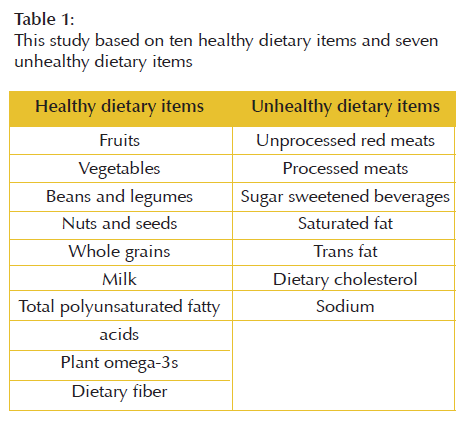Dietary quality among adults in 187 countries between 1990 and 2010
The aim of the study was to characterize global trends in dietary patterns nationally and regionally in 1990 and 2010 across 187 nations and to assess heterogeneity by age, sex, national income, and type of dietary pattern.
325 surveys studied, 10 healthy dietary items and seven unhealthy dietary items
Consumption data were evaluated from 325 surveys (71.7% nationally representative) covering 88.7% of the global adult population. Two types of dietary pattern were assessed:
- one reflecting greater consumption of healthy diet (10 items) and
- the other based on lesser consumption of unhealthy diet (seven items) – cf. Table 1.

The mean intakes of each dietary factor were divided into quintiles, and each quintile was assigned an ordinal score, with higher scores being equivalent to healthier diets, from 0 (less healthy) to 100 (more healthy). The dietary patterns were assessed by hierarchical linear regression including country, age, sex, national income, and time as exploratory variables.
Diets based on healthy items improved globally while consumption of unhealthy items worsened across the world
From 1990 to 2010, it was observed that consumption of healthier foods and nutrients has modestly increased during the past two decades (by 2.2 points, 95% UI 0·9–3·5). By contrast, global dietary patterns based on fewer unhealthy items worsened (-2.5; 95% UI -3.3 to -1.7), indicating concomitant increased consumption of these unhealthy foods and nutrients. In 2010, the global mean scores were 44.0 (SD 10.5) for the healthy pattern and 52.1 (18.6) for the unhealthy pattern, with weak intercorrelation (r=–0.08) between countries.
Diets and their trends were very heterogeneous across the world regions
These trends that were observed were weakly correlated across countries (r=–0.08 overall, range –0.15 to 0.09 in the four national-income categories; p>0.05 each).These trends did not significantly vary by age or sex (p>0.4 each), but significantly varied by national income (p<0.02 each). Nations with higher incomes had larger improvements in diet patterns based on healthy items than did nations with lower incomes.
Although most world regions showed modest improvements in dietary patterns between 1990 and 2010 on the basis of more healthy items, such improvements were generally not noted in the poorest regions, including in sub-Saharan Africa and the Andean states of Latin America. Conversely, most regions of the world showed substantial declines in diet quality based on increased consumption of unhealthy items. The exceptions included many of the wealthiest regions including the United States and Canada, Western Europe, Australia, and New Zealand, where consumption of these unhealthy items modestly decreased.
Better diets were observed for older adults and women On average, better diets were seen in older adults compared with younger adults, and in women compared with men (p<0.0001 each).
| To our knowledge, this is the first study to evaluate dietary patterns among adults across the world. In 187 countries between 1990 and 2010, dietary patterns and their trends over time varied substantially depending on differences between healthy and unhealthy foods. The global variations were largely undetectable if one scale of diet quality was evaluated, as has been previously done1,2.
Global public health should recognise diverse dietary trends based on healthy versus unhealthy foods, identify determinants of this diversity, and improve strategies for global, transnational, and domestic policy actions with a joint consideration of both healthy and unhealthy foods. |
Based on: Imamura F., Micha R., Khatibzadeh S., Fahimi S., Shi P., Powles J., Mozaffarian D.; Global Burden of Diseases Nutrition and Chronic Diseases Expert Group (NutriCoDE). Dietary quality among men and women in 187 countries in 1990 and 2010: a systematic assessment. Lancet Glob Health. 2015 Mar;3(3):e132-42. .
References
- Vandevijvere S, Monteiro C, Krebs-Smith SM, et al. Monitoring and benchmarking population diet quality globally: a step-wise approach. Obes Rev 2013; 14:135–49.
- Contribution O, Teo K, Lear S, et al. Prevalence of a healthy lifestyle among individuals with cardiovascular disease in high-, middle- and low-income countries: the Prospective Urban Rural Epidemiology (PURE) study. JAMA 2013; 309:1613–21
